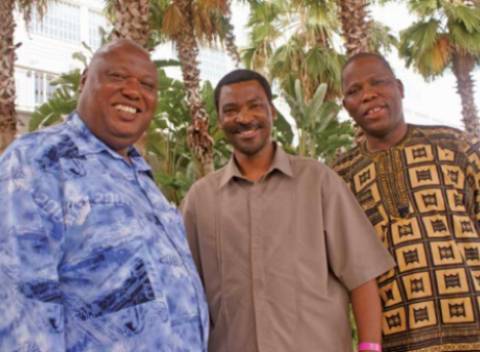Growing Churches in Mozambique

Holiness Today dialogued with three district superintendents in Mozambique:
Eduardo Novele (EN), Chibuto District
José Moiane (JM), Maputo District
André Chilengue (AC), Matola District
Growing churches on these three districts use common efforts in evangelism, discipleship, and leadership training. Get acquainted with these three African leaders and learn about concepts for growth in the church community and in their own lives.
HT: What are some of the challenges you face as district superintendents?
EN: The first challenge is that we want to construct a district center. The church we use now is quite small. It is difficult to gather the district in that space. Secondly, our challenge is to plant more churches and win more souls to Christ.
JM: We have a plan to see 20 percent growth on the district. We are busy planting new churches. Each year in our plan, we set a percentage goal for growth, which we reach or exceed. To win souls and gain members, discipling those new believers, are challenges. Training new pastors for the new churches is another challenge.
AC: On the Matola District, we have had a great challenge since 2007. This is well known by everyone on the district. We have a 10-year plan, from 2007-17, to plant 65 churches during that decade. To do this we need to train 60 pastors in 10 years.
The plan has been started and we are seeing wonderful results. We have started 3 new churches and around 24 new preaching points, which have not yet been developed as churches. Also, we have built a district center. Getting that operational is a goal since it is in the final phases of completion.
HT: How do you stay inspired so that you have more to keep giving to your constituents and pastors?
JM: We share our vision with the pastors. And also, together we see how to make this happen. It's not just us on our own.
EN: When we have our district assemblies, we have growth goals. Our district has had a goal of 13 percent for the year. So at end of the assembly, each pastor leaves with a concept of the new numbers needed for that year.
Also, we have quarterly meetings where each pastor gives a report as to how the work is going. The ones who reach the goals are given certificates, to help recognize the progress and keep everyone focused.
AC: As a district, after the assembly, we have quarterly meetings with the pastors. A day is set aside from training and meetings for prayer. Then in the training times, we inspire the pastors. In my role as DS, I plan to visit each church. Every Sunday I am in a different church. I try to help each church individually and recognize difficulties that church may be facing.
Putting goals in place is a way of representing souls. We encourage laity and pastors to focus on the lost souls, which are represented in numbers, goals, and percentages.
HT: What are reasons for your growth?
AC: When the superintendent visits a church, it's not just about preaching. We also meet with the church board, perhaps on a Saturday. In that meeting, we find out the progress and difficulties facing the church. Then we can help to guide and mentor the pastor and people.
According to the Manual, we have two types of churches. Self-supporting churches and newly-organized, not yet self-supporting churches.
If the superintendent realizes that a new church is having difficulties, we may change a pastor and try to get the best fit of pastor and congregation. So we look at the location of the church and the gifts of the pastors. The location may determine who pastors there. A location may call for a pastor with strong gifts for evangelism or discipleship training.
JM: Another reason for growth is aggressive evangelism. In Mozambique, we are using the slogan: 'Each one reach one, each pastor train another pastor, each church plant a new church.' Where new churches are being planted, there are extension areas and the possibility of reaching more people.
Also the JESUS Film is used. If we see a church struggling, we'll send a film team there. This helps attract new people and revive the existing church.
EN: Those churches that fail to reach their goals help the superintendent focus. I will visit these churches more frequently and work with the pastors to help find ways to grow. When I visit a church, I meet with the board on Saturday, then I preach on Sunday morning, and teach a training session that afternoon. In the training, I give lessons based on the needs of the church. Many of these elements are seen on the districts across Mozambique.
HT: How do you stay spiritually healthy?
EN: I set aside time for prayer and reading the Bible. At the end of the day, I have an hour with my family for prayer and sharing. My wife, Angelina, and I raised our three children like this, ending our day together. We made a schedule so that each day, one of us--children and parents--were prepared to share the Word.
JM: My wife, Helena, and I also have a prayer and family time, but we chose one of our four children to be the secretary of the family, making the schedule and planning this time. Music is also a part of our family worship. In that time for prayer, we also pray for the pastors on our district and for the work of God to be seen.
AC: Our family prays together. Besides being a district superintendent, I am still a pastor at heart.
Before I preach, I read the doctrine of the church. I talk to our four children about the Bible, then we pray as a family for about an hour. Another thing that encourages us is that my wife, Cacilda, and I pray together for an hour.
*Obadias Muhandzule, an educator at Seminario Nazareno em Mozambique and pastor of the Motola City Church of the Nazarene served as interpreter for this interview.
Facts About Mozambique
Mozambique Population: 21,669,278
Location: Southeastern Africa, bordering the Mozambique Channel, between South Africa and Tanzania.
Religions:
Catholic-- 24 percent.
Muslim-- 18 percent.
Zionist Christian-- 17 percent.
Other-- 18 percent.
None-- 23 percent.
Language: Portuguese is the official language.
Source: CIA Factbook
Holiness Today, 2010
Please note: This article was originally published in 2010. All facts, figures, and titles were accurate to the best of our knowledge at that time but may have since changed.




